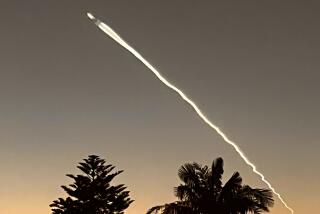NASA Unfurls Electric Wire in Space Tether Test
- Share via
KENNEDY SPACE CENTER, Fla. — NASA unfurled 1,640 feet of copper wire high above Earth on Saturday and conducted electricity through the line in a low-cost space tether test.
“I rate this as a full success,” National Aeronautics and Space Administration physicist Jim McCoy said. “We’re getting at least a third of an amp in both directions.”
Such tethers, once refined, could be used to dispel electrical charges from spacecraft, including a space station, and change spacecraft orbits.
NASA’s tether spool was carried into space Saturday by a Delta rocket launched by the Air Force. The rocket’s primary payload was a $65-million Navstar Global Positioning System satellite.
It was the space agency’s third attempt to unreel a tether in space, and it also was the cheapest. The experiment cost from $3 million to $4 million, less than half of the price of the last tether test in March, which was also launched from a Delta rocket, and was 100 times cheaper than the tethered satellite that flew on the shuttle Atlantis last summer.
This tether is considerably shorter, one-third of a mile compared with 12 1/2 miles of cord on the first two experiments. The tether unwound all of the way in March but never got past 840 feet last summer because of a protruding bolt that caused the line to jam.
Length was not important this time, McCoy said. The main objective was to see whether hollow cathode tubes--one on either end of the tether--could ionize xenon gas, release it into space and thus produce an electrical ground.
McCoy said data radioed to the ground indicated that the cathode tubes worked as expected.
The tether is one-sixteenth of an inch thick and consists of strands of 18-gauge copper wire lightly coated with Teflon for insulation.
Once fully extended, it picked up electrical current from one end and moved it to the other end and out into space, all in a matter of milliseconds, McCoy said. The tether generated 50 to 100 volts while speeding through Earth’s magnetic field.
Unlike NASA’s first two tether experiments, there are no cutters to release this tether. The tether will remain attached to the spent booster until the rocket plunges through the atmosphere in a few months and burns up.
More to Read
Sign up for Essential California
The most important California stories and recommendations in your inbox every morning.
You may occasionally receive promotional content from the Los Angeles Times.











